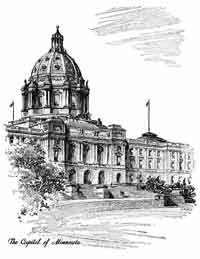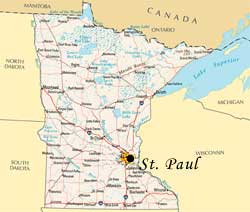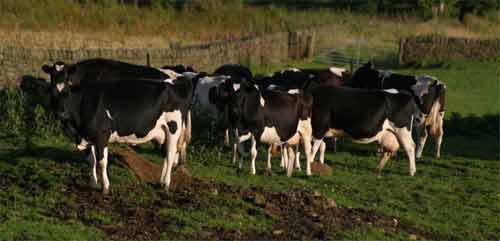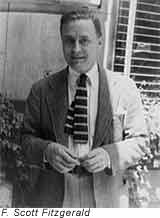
 Minnesota is named after the Minnesota River. The river got its name from the Sioux Indian word "Minisota." That word comes from the words "minni," meaning "water," and "sotah," meaning "sky-tinted" or "cloudy." Therefore, Minnesota means "sky-tinted water" or "cloudy water." The Indians gave the river this name because of the blue clay that washed into it. Minnesota is named after the Minnesota River. The river got its name from the Sioux Indian word "Minisota." That word comes from the words "minni," meaning "water," and "sotah," meaning "sky-tinted" or "cloudy." Therefore, Minnesota means "sky-tinted water" or "cloudy water." The Indians gave the river this name because of the blue clay that washed into it.
Minnesota has many nicknames. It is known as the "Gopher State." However, no one is sure of the exact origin of that nickname. Some people believe the state got the nickname because ravenous gophers chew farm crops there.
Others think the name came from a 19th century political cartoon that showed dishonest railroad union organizers as gophers.
Minnesota is also known as the "Bread and Butter State" because of its numerous flourmills and butter-making plants. Another nickname for the state is the "Land of 10,000 Lakes." Minnesota has over 15,000 lakes, however. Some people call Minnesota the "North Star State" because of the translation of the French motto, "L'Etoile de Nord," that's on the state seal. The abbreviation for Minnesota is MN.

 Minnesota is a West North Central state bordered by Canada to the north, Wisconsin to the east, Iowa to the south, and North Dakota and South Dakota to the west. The state's Northwest Angle is the northernmost point in the continental (that is, not including Hawaii and Alaska) United States. Minnesota is a West North Central state bordered by Canada to the north, Wisconsin to the east, Iowa to the south, and North Dakota and South Dakota to the west. The state's Northwest Angle is the northernmost point in the continental (that is, not including Hawaii and Alaska) United States.
Minnesota is located near the geographic center of North America. The state's landscape includes valleys, prairies, wilderness, high bluffs, rocky shores, and thousands of lakes. It's the largest state in the Midwest and ranks 12th overall.
The twin cities of Minneapolis and Saint Paul can be found in Minnesota. Minneapolis is the state's largest city.

Minnesota is an important dairy state; it is one of the leading producers of milk in the country. The state is also a leading producer of hogs, corn, soybeans, and wheat. General Mills, Pillsbury, and Land O'Lakes are important food processing companies that are located in Minnesota. Food processing is the second most important industry in the state.

Minnesota is an important industrial state. It produces medical products, fabricated metals, machinery, and electrical goods. In addition, Minnesota is a leader in technology and electronics. Control Data, 3M, and Honeywell are important technology and electronics companies headquartered in Minnesota. The state leads the nation in iron mining. Finally, service industries, including finance and trade, are also important to Minnesota's economy.

People visit Minnesota for many different reasons. The state's scenic beauty, lakes, and woods make it a popular choice for vacationers. If you like to hunt, fish, camp, canoe, or hike, go to Minnesota. Visit Duluth, the country's leading Great Lakes port. In addition, Minnesota has set aside more area than any other state for the protection and preservation of game animals.
If you'd rather ride a roller coaster or shop until you drop, Minnesota may be the place for you. There are movie theaters, nightclubs, an indoor amusement park, and about 400 stores at the Mall of America, located in Bloomington. See ski-jumping and ice sculpture contests at the Winter Carnival in St.Paul, the state's capital. Other people go to Minnesota to seek treatment at the famous Mayo Clinic, one of the world's largest medical centers.

 Minnesota is also famous for its many famous writers. F. Scott Fitzgerald, one of the most important American writers of the 1920s, was born in the state. Visit Sauk Centre, a small Minnesota town and the setting for Sinclair Lewis' famous novel, "Main Street." In 1930, Lewis, who was born in the small town, became the first American to win the Nobel Prize for literature. Minnesota is also famous for its many famous writers. F. Scott Fitzgerald, one of the most important American writers of the 1920s, was born in the state. Visit Sauk Centre, a small Minnesota town and the setting for Sinclair Lewis' famous novel, "Main Street." In 1930, Lewis, who was born in the small town, became the first American to win the Nobel Prize for literature.
|

![]()
